Balancing Resource Potential and Investment Costs in Offshore Wind Projects: Evidence from Northern Colombia
Abstract
1. Introduction
2. Materials and Methods
2.1. Study Area and Datasets
2.2. Hub Height Winds and Performance Modeling
2.3. Integrated Techno-Economic Assessment
Regulatory Assumptions and Modeling Boundaries
3. Results and Discussion
3.1. Offshore Wind Conditions Based on RWY Data
3.2. Influence of Air Density Variation on Wind Power Potential
3.3. Wind Speed Distribution Analysis and Weibull Characterization
3.4. Wind Direction Analysis Based on Wind Rose Patterns
3.5. Offshore Wind Generation Potential and Temporal Variability
3.6. Techno-Economic Assessment by Region
4. Conclusions
Author Contributions
Funding
Data Availability Statement
Acknowledgments
Conflicts of Interest
Abbreviations
| CAPEX | Capital Expenditure |
| Cf | Capacity Factor |
| ERA5 | ECMWF Reanalysis v5 |
| ECMWF | European Centre for Medium-Range Weather Forecasts |
| FAHP | Fuzzy Analytic Hierarchy Process |
| FRT | Fault Ride Through |
| FS | Finkelstein–Schafer distance |
| GIS | Geographic Information System |
| HVAC | High-Voltage Alternating Current |
| HVDC | High-Voltage Direct Current |
| IBRs | Inverter Based Resources |
| IRENA | International Renewable Energy Agency |
| MLM | Maximum Likelihood Method |
| NREL | National Renewable Energy Laboratory |
| OPEX | Operational Expenditure |
| RMSE | Root Mean Square Error |
| RWY | Reference Wind Year |
| TLPs | Tension Leg Platforms |
References
- Saleh, H.M.; Hassan, A.I. The Challenges of Sustainable Energy Transition: A Focus on Renewable Energy. Appl. Chem. Eng. 2024, 7, 2084. [Google Scholar] [CrossRef]
- Osman, A.I.; Chen, L.; Yang, M.; Msigwa, G.; Farghali, M.; Fawzy, S.; Rooney, D.W.; Yap, P.-S. Cost, Environmental Impact, and Resilience of Renewable Energy under a Changing Climate: A Review. Environ. Chem. Lett. 2023, 21, 741–764. [Google Scholar] [CrossRef]
- Decastro, M.; Salvador, S.; Gómez-Gesteira, M.; Costoya, X.; Carvalho, D.; Sanz-Larruga, F.J.; Gimeno, L. Europe, China and the United States: Three Different Approaches to the Development of Offshore Wind Energy. Renew. Sustain. Energy Rev. 2019, 109, 55–70. [Google Scholar] [CrossRef]
- Kosek, W.; Woźniak, W.; Chamier-Gliszczynski, N.; Staniuk, W. Offshore Wind Farm Supply Chains and Regional Development: The Role of Ports in Economic and Logistical Growth in the Central Baltic Region. Energies 2025, 18, 2599. [Google Scholar] [CrossRef]
- von Jouanne, A.; Agamloh, E.; Yokochi, A. A Review of Offshore Renewable Energy for Advancing the Clean Energy Transition. Energies 2025, 18, 4798. [Google Scholar] [CrossRef]
- Urban, F. China’s Rise: Challenging the North-South Technology Transfer Paradigm for Climate Change Mitigation and Low Carbon Energy. Energy Policy 2018, 113, 320–330. [Google Scholar] [CrossRef]
- Majidi Nezhad, M.; Neshat, M.; Piras, G.; Astiaso Garcia, D. Sites Exploring Prioritisation of Offshore Wind Energy Potential and Mapping for Wind Farms Installation: Iranian Islands Case Studies. Renew. Sustain. Energy Rev. 2022, 168, 112791. [Google Scholar] [CrossRef]
- Wen, Y.; Kamranzad, B.; Lin, P. Assessment of Long-Term Offshore Wind Energy Potential in the South and Southeast Coasts of China Based on a 55-Year Dataset. Energy 2021, 224, 120225. [Google Scholar] [CrossRef]
- Görmüş, T.; Aydoğan, B.; Ayat, B. Offshore Wind Power Potential Analysis for Different Wind Turbines in the Mediterranean Region, 1959–2020. Energy Convers. Manag. 2022, 274, 116470. [Google Scholar] [CrossRef]
- Carreno-Madinabeitia, S.; Ibarra-Berastegi, G.; Sáenz, J.; Ulazia, A. Long-Term Changes in Offshore Wind Power Density and Wind Turbine Capacity Factor in the Iberian Peninsula (1900–2010). Energy 2021, 226, 120364. [Google Scholar] [CrossRef]
- The Renewables Consulting Group & ERM. Hoja de Ruta Para El Despliegue de La Energía Eólica Costa Afuera En Colombia; The Renewables Consulting Group: London, UK, 2022. [Google Scholar]
- Gil Ruiz, S.A.; Cañón Barriga, J.E.; Martínez, J.A. Assessment and Validation of Wind Power Potential at Convection-Permitting Resolution for the Caribbean Region of Colombia. Energy 2022, 244, 123127. [Google Scholar] [CrossRef]
- Arce, L. Analysis of Offshore Wind Energy in Colombia: Current Status and Future Opportunities. Int. J. Eng. Res. 2020, 9, 610–619. [Google Scholar] [CrossRef]
- Rueda-Bayona, J.G.; Guzmán, A.; Eras, J.J.C.; Silva-Casarín, R.; Bastidas-Arteaga, E.; Horrillo-Caraballo, J. Renewables Energies in Colombia and the Opportunity for the Offshore Wind Technology. J. Clean. Prod. 2019, 220, 529–543. [Google Scholar] [CrossRef]
- Ospino-Castro, A.; Robles-Algarín, C.; Mangones-Cordero, A.; Romero-Navas, S. An Analytic Hierarchy Process Based Approach for Evaluating Feasibility of Offshore Wind Farm on the Colombian Caribbean Coast. Int. J. Energy Econ. Policy 2023, 13, 64–73. [Google Scholar] [CrossRef]
- Maldonado, M.D.L.A.; Calderon, J.K.M.; Maldonado, Y.A.M.; Ospino, A. Technical and Economic Evaluation of a Small-Scale Wind Power System Located in Berlin, Colombia. TECCIENCIA 2019, 13, 63–72. [Google Scholar] [CrossRef]
- Pabón Hernández, S.M. Geospatial Assessment of the Wind Energy for an Onshore Project in the Caribbean Region of Colombia. Master’s Thesis, Hochschule für Angewandte Wissenschaften Hamburg, Hamburg, Germany, 2019. [Google Scholar]
- Dong, Z.; Zhao, Y.; Wang, A.; Zhou, M. Wind-Mambaformer: Ultra-Short-Term Wind Turbine Power Forecasting Based on Advanced Transformer and Mamba Models. Energies 2025, 18, 1155. [Google Scholar] [CrossRef]
- Yang, M.; Jiang, Y.; Che, J.; Han, Z.; Lv, Q. Short-Term Forecasting of Wind Power Based on Error Traceability and Numerical Weather Prediction Wind Speed Correction. Electronics 2024, 13, 1559. [Google Scholar] [CrossRef]
- Kovalnogov, V.N.; Fedorov, R.V.; Chukalin, A.V.; Klyachkin, V.N.; Tabakov, V.P.; Demidov, D.A. Applied Machine Learning to Study the Movement of Air Masses in the Wind Farm Area. Energies 2024, 17, 3961. [Google Scholar] [CrossRef]
- Martinez G, R.J.; Ballesteros M, C.A.; Valencia O, G.E.; Ch, M.C.V.; Polanco P, G. Study of Wind Persistence and Density of Wind Power in La Guajira-Colombia. Contemp. Eng. Sci. 2017, 10, 963–971. [Google Scholar] [CrossRef]
- Villegas, J.F.; Ochoa, G.V.; Chamorro, M.V. Statistical Analysis of Wind Power and Analytical Methods for Wind Persistence in Magdalena and Cesar Departments in Colombia. Indian J. Sci. Technol. 2017, 10, 1–09. [Google Scholar] [CrossRef]
- Hernández-Escobedo, Q.; Saldaña-Flores, R.; Rodríguez-García, E.R.; Manzano-Agugliaro, F. Wind Energy Resource in Northern Mexico. Renew. Sustain. Energy Rev. 2014, 32, 890–914. [Google Scholar] [CrossRef]
- Rodriguez-Caviedes, A.; Gil-García, I.C. Multifactorial Analysis to Determine the Applicability of Wind Power Technologies in Favorable Areas of the Colombian Territory. Wind 2022, 2, 357–393. [Google Scholar] [CrossRef]
- Carta, J.A.; Ramírez, P.; Velázquez, S. A Review of Wind Speed Probability Distributions Used in Wind Energy Analysis. Renew. Sustain. Energy Rev. 2009, 13, 933–955. [Google Scholar] [CrossRef]
- Portillo Diaz, C.D.; Montiel Hoyos, C.C.; Montes Páez, E.G.; Guerrero Martin, C.A. Wind Potencial as an Oportunity for Energy Transition in Oil and Gas Industry: Colombian Caribbean Offshore Case of Study. In Proceedings of the Offshore Technology Conference, Houston, TX, USA, 25 April 2022; p. OTC-31911-MS. [Google Scholar]
- Moreno, C.; Ospino-Castro, A.; Robles-Algarín, C. Decision-Making Support Framework for Electricity Supply in Non-Interconnected Rural Areas Based on FAHP. Int. J. Energy Econ. Policy 2022, 12, 79–87. [Google Scholar] [CrossRef]
- Haghighat Mamaghani, A.; Avella Escandon, S.A.; Najafi, B.; Shirazi, A.; Rinaldi, F. Techno-Economic Feasibility of Photovoltaic, Wind, Diesel and Hybrid Electrification Systems for off-Grid Rural Electrification in Colombia. Renew. Energy 2016, 97, 293–305. [Google Scholar] [CrossRef]
- Raza, M.A.; Aman, M.M.; Rajpar, A.H.; Bashir, M.B.A.; Jumani, T.A. Towards Achieving 100% Renewable Energy Supply for Sustainable Climate Change in Pakistan. Sustainability 2022, 14, 16547. [Google Scholar] [CrossRef]
- Ji, R.; Zheng, J.; Xue, M.; Sun, K.; Ye, Y.; Zhu, R.; Fernandez-Rodriguez, E.; Zhang, Y. Investigations on the Performance and Wake Dynamics of a Tidal Stream Turbine under Different Yaw-Offset Conditions. Phys. Fluids 2025, 37, 015192. [Google Scholar] [CrossRef]
- Castro, A.O.; Robles-Algarín, C.; Hernández-Callejo, L.; Muñoz Maldonado, Y.; Cordero, A.M. Feasibility Analysis of Offshore Wind Power Projects in the Caribbean Region of Colombia: A Case Study Using FAHP–GIS. Sustainability 2023, 15, 16620. [Google Scholar] [CrossRef]
- Bastidas-Salamanca, M.; Rueda-Bayona, J.G. Pre-Feasibility Assessment for Identifying Locations of New Offshore Wind Projects in the Colombian Caribbean. Int. J. Sustain. Energy Plan. Manag. 2021, 32, 139–154. [Google Scholar] [CrossRef]
- Hersbach, H.; Bell, B.; Berrisford, P.; Hirahara, S.; Horányi, A.; Muñoz--Sabater, J.; Nicolas, J.; Peubey, C.; Radu, R.; Schepers, D.; et al. The ERA5 Global Reanalysis. Q. J. R. Meteorol. Soc. 2020, 146, 1999–2049. [Google Scholar] [CrossRef]
- Copernicus Climate Change Service (C3S) ERA5 Hourly Data on Single Levels from 1940 to Present. Available online: https://cds.climate.copernicus.eu/datasets/reanalysis-era5-single-levels?tab=overview (accessed on 21 September 2025).
- Pusat, S.; Karagöz, Y. A New Reference Wind Year Approach to Estimate Long Term Wind Characteristics. Adv. Mech. Eng. 2021, 13, 16878140211021268. [Google Scholar] [CrossRef]
- Zhao, Y.; Ding, C. Wind Power Generator Output Model Based on the Statistical Wind Speed Distribution Derived from the Historical Data. In Proceedings of the 2018 2nd IEEE Conference on Energy Internet and Energy System Integration (EI2), Beijing, China, 20–22 October 2018; pp. 1–5. [Google Scholar]
- Viteri, J.P.; Henao, F.; Cherni, J.; Dyner, I. Optimizing the Insertion of Renewable Energy in the Off-Grid Regions of Colombia. J. Clean. Prod. 2019, 235, 535–548. [Google Scholar] [CrossRef]
- ABB Cuaderno de Aplicaciones Técnicas n.° 12: Plantas Eólicas. Available online: https://library.e.abb.com/public/ac764cb1be081128c1257a30003c70d7/Cuaderno%20Tecnico_num%2012_Plantas%20eolicas.pdf (accessed on 24 October 2025).
- Escudero López, J.M. Manual de Energía Eólica; Ediciones Mundi-Prensa: Madrid, Spain, 2008. [Google Scholar]
- Rodríguez, E.; Castro, L.L.; Santamaría, G.; Lezama, U. Obtención de la Curva de Potencia de un Aerogenerador de 2 mw, Mediante un Modelo CFD (Obtainment of the Power Curve of a Wind Turbine 2 mw, Through a CFD Model); Pistas Educativas: Celaya, Mexico, 2018; Volume 40. [Google Scholar]
- Namiranian, A. 3D Simulation of a 5MW Wind Turbine. Master’s Thesis, Blekinge Institute of Technology, Karlskrona, Sweden, 2011. [Google Scholar]
- González-Hernández, J.G.; Salas-Cabrera, R. Representation and Estimation of the Power Coefficient in Wind Energy Conversion Systems. Rev. Fac. Ing. 2019, 28, 77–90. [Google Scholar] [CrossRef]
- Sahroni, T.R. Modeling and Simulation of Offshore Wind Power Platform for 5 MW Baseline NREL Turbine. Sci. World J. 2015, 2015, 819384. [Google Scholar] [CrossRef] [PubMed]
- Nejad, A.R.; Guo, Y.; Gao, Z.; Moan, T. Development of a 5 MW Reference Gearbox for Offshore Wind Turbines. Wind. Energy 2016, 19, 1089–1106. [Google Scholar] [CrossRef]
- Ioannou, A.; Angus, A.; Brennan, F. A Lifecycle Techno-Economic Model of Offshore Wind Energy for Different Entry and Exit Instances. Appl. Energy 2018, 221, 406–424. [Google Scholar] [CrossRef]
- Stehly, T.; Duffy, P.; Mulas Hernando, D. Cost of Wind Energy Review: 2024 Edition. Available online: https://docs.nrel.gov/docs/fy25osti/91775.pdf (accessed on 20 October 2025).
- BVG Associates Guide to an Offshore Wind Farm: Wind Farm Costs. Available online: https://guidetoanoffshorewindfarm.com/wind-farm-costs/ (accessed on 22 October 2025).
- Guo, Y.; Wang, H.; Lian, J. Review of Integrated Installation Technologies for Offshore Wind Turbines: Current Progress and Future Development Trends. Energy Convers. Manag. 2022, 255, 115319. [Google Scholar] [CrossRef]
- de Montera, L.; Berger, H.; Husson, R.; Appelghem, P.; Guerlou, L.; Fragoso, M. High-Resolution Offshore Wind Resource Assessment at Turbine Hub Height with Sentinel-1 Synthetic Aperture Radar (SAR) Data and Machine Learning. Wind. Energy Sci. 2022, 7, 1441–1453. [Google Scholar] [CrossRef]
- Bilgili, M.; Alphan, H.; Ilhan, A. Potential Visibility, Growth, and Technological Innovation in Offshore Wind Turbines Installed in Europe. Environ. Sci. Pollut. Res. 2022, 30, 27208–27226. [Google Scholar] [CrossRef] [PubMed]
- Peña, A.; Floors, R.; Sathe, A.; Gryning, S.-E.; Wagner, R.; Courtney, M.S.; Larsén, X.G.; Hahmann, A.N.; Hasager, C.B. Ten Years of Boundary-Layer and Wind-Power Meteorology at Høvsøre, Denmark. Bound. Layer. Meteorol. 2016, 158, 1–26. [Google Scholar] [CrossRef]
- Hsu, S.A. A Dynamic Roughness Equation and Its Application to Wind Stress Determination at the Air-Sea Interface. J. Phys. Ocean. 1974, 4, 116–120. [Google Scholar] [CrossRef]
- Wu, L.; Sahlée, E.; Nilsson, E.; Rutgersson, A. A Review of Surface Swell Waves and Their Role in Air–Sea Interactions. Ocean Model 2024, 190, 102397. [Google Scholar] [CrossRef]
- Hasani-Marzooni, M.; Hosseini, S.H. Dynamic Model for Market-Based Capacity Investment Decision Considering Stochastic Characteristic of Wind Power. Renew. Energy 2011, 36, 2205–2219. [Google Scholar] [CrossRef]
- Guevara Díaz, J.M. Cuantificación Del Perfil Del Viento Hasta 100 m de Altura Desde La Superficie y Su Incidencia En La Climatología Eólica. Terra 2013, 29, 81–101. [Google Scholar]
- Bäckbro, H. A Study of Potential Approaches to Simulate Power Output as Well as Identifying Anomalous Operation of Wind Turbines. Master’s Thesis, Uppsala University, Uppsala, Sweden, 2014. [Google Scholar]
- Jalalvand, M.; Almassi, M.; Bakhoda, H. Statistical Wind Data Analysis Based on Weibull Distribution Function for Partial Utility in Agricultural Application (Case Study: Broujerd Province, Iran). J. Agric. Mech. 2021, 6, 67–75. [Google Scholar]
- Batran, S.; Jama, M.; Yousaf, J.; Hassan, T.; Ghazal, M.; Mokhlis, H. Bin Assessment of Wind Energy Resource in the Western Region of Somaliland. Heliyon 2024, 10, e32500. [Google Scholar] [CrossRef] [PubMed]
- Negash, T.; Möllerström, E.; Ottermo, F. An Assessment of Wind Energy Potential for the Three Topographic Regions of Eritrea. Energies 2020, 13, 1846. [Google Scholar] [CrossRef]
- Ulazia, A.; Nafarrate, A.; Ibarra-Berastegi, G.; Sáenz, J.; Carreno-Madinabeitia, S. The Consequences of Air Density Variations over Northeastern Scotland for Offshore Wind Energy Potential. Energies 2019, 12, 2635. [Google Scholar] [CrossRef]
- Ulazia, A.; Sáenz, J.; Ibarra-Berastegi, G.; González-Rojí, S.J.; Carreno-Madinabeitia, S. Global Estimations of Wind Energy Potential Considering Seasonal Air Density Changes. Energy 2019, 187, 115938. [Google Scholar] [CrossRef]
- Salih, A.-K.M.; Hatem Kamil, M. Assessment of Relative Humidity Effect on Wind Power for Electricity Production in Al-Samawa City-Southern Iraq. Am. Sci. Res. J. Eng. Technol. Sci. 2020, 68, 74–84. [Google Scholar]
- Pérez Rendón, E.P.; Ramírez Builes, V.H.; Peña Quiñones, A.J. Variabilidad Espacial y Temporal de La Temperatura Del Aire En La Zona Cafetera Colombiana. Investig. Geográficas 2016, 89, 23–40. [Google Scholar] [CrossRef]
- Tizgui, I.; El Guezar, F.; Bouzahir, H.; Benaid, B. Comparison of Methods in Estimating Weibull Parameters for Wind Energy Applications. Int. J. Energy Sect. Manag. 2017, 11, 650–663. [Google Scholar] [CrossRef]
- Guenoukpati, A.; Salami, A.A.; Kodjo, M.K.; Napo, K. Estimating Weibull Parameters for Wind Energy Applications Using Seven Numerical Methods: Case Studies of Three Costal Sites in West Africa. Int. J. Renew. Energy Dev. 2020, 9, 217–226. [Google Scholar] [CrossRef]
- Vega-Zuñiga, S.; Rueda-Bayona, J.G.; Ospino-Castro, A. Evaluation of Eleven Numerical Methods for Determining Weibull Parameters for Wind Energy Generation in the Caribbean Region of Colombia. Math. Model. Eng. Probl. 2022, 09, 194–199. [Google Scholar] [CrossRef]
- Chang, T.P. Performance Comparison of Six Numerical Methods in Estimating Weibull Parameters for Wind Energy Application. Appl. Energy 2011, 88, 272–282. [Google Scholar] [CrossRef]
- Mohammadi, K.; Alavi, O.; Mostafaeipour, A.; Goudarzi, N.; Jalilvand, M. Assessing Different Parameters Estimation Methods of Weibull Distribution to Compute Wind Power Density. Energy Convers. Manag. 2016, 108, 322–335. [Google Scholar] [CrossRef]
- Shoaib, M.; Siddiqui, I.; Ahmed, F.; Rehman, S.U.; Tanveer, M.R.; Jilani, S.U. Weibull Distribution Function for Wind Energy Estimation of Gharo (Sindh). J. Basic Appl. Sci. 2015, 11, 106–114. [Google Scholar] [CrossRef]
- Belabes, B.; Youcefi, A.; Guerri, O.; Djamai, M.; Kaabeche, A. Evaluation of Wind Energy Potential and Estimation of Cost Using Wind Energy Turbines for Electricity Generation in North of Algeria. Renew. Sustain. Energy Rev. 2015, 51, 1245–1255. [Google Scholar] [CrossRef]
- Yancachajlla Tito, U.; Vilca Huayta, O.A. Caracterización Del Viento Con La Función de Weibull Para Una Zona Altoandina, Laraqueri-Perú. Rev. De Investig. Altoandinas. 2022, 24, 190–198. [Google Scholar] [CrossRef]
- Kalmikov, A. Wind Power Fundamentals. In Wind Energy Engineering; Elsevier: Amsterdam, The Netherlands, 2017; pp. 17–24. [Google Scholar]
- Sedaghat, A.; Alkhatib, F.; Eilaghi, A.; Mehdizadeh, A.; Borvayeh, L.; Mostafaeipour, A.; Hassanzadeh, A.; Jahangiri, M. Optimization of Capacity Factors Based on Rated Wind Speeds of Wind Turbines. Energy Sources Part A Recovery Util. Environ. Eff. 2024, 46, 6104–6125. [Google Scholar] [CrossRef]
- Gugliani, G.K.; Sarkar, A.; Ley, C.; Mandal, S. New Methods to Assess Wind Resources in Terms of Wind Speed, Load, Power and Direction. Renew. Energy 2018, 129, 168–182. [Google Scholar] [CrossRef]
- Xu, J.; Zou, J.; Ziegler, A.D.; Wu, J.; Zeng, Z. What Drives the Change of Capacity Factor of Wind Turbine in the United States? Environ. Res. Lett. 2023, 18, 064009. [Google Scholar] [CrossRef]
- Wind Europe Capacity Factors. Available online: https://windeurope.org/about-wind/daily-wind/capacity-factors (accessed on 22 September 2025).
- IRENA. Floating Offshore Wind Outlook; International Renewable Energy Agency: Abu Dhabi, United Arab Emirates, 2024; ISBN 978-92-9260-612-1. [Google Scholar]
- Lorentzen, S.; Osmundsen, P.; Lu, L. Immature Offshore Wind Technology: UK Life Cycle Capacity Factor Analysis. Wind. Energy 2024, 27, 1095–1110. [Google Scholar] [CrossRef]
- Fernández, L. Global Offshore Wind Capacity Factor 2010–2023. Available online: https://www.statista.com/statistics/1368679/global-offshore-wind-capacity-factor/ (accessed on 22 September 2025).
- Chang, T.-P.; Liu, F.-J.; Ko, H.-H.; Cheng, S.-P.; Sun, L.-C.; Kuo, S.-C. Comparative Analysis on Power Curve Models of Wind Turbine Generator in Estimating Capacity Factor. Energy 2014, 73, 88–95. [Google Scholar] [CrossRef]
- Effiom, S.O.; Nwankwojike, B.N.; Abam, F.I. Economic Cost Evaluation on the Viability of Offshore Wind Turbine Farms in Nigeria. Energy Rep. 2016, 2, 48–53. [Google Scholar] [CrossRef]
- Papi, F.; Bianchini, A. Technical Challenges in Floating Offshore Wind Turbine Upscaling: A Critical Analysis Based on the NREL 5 MW and IEA 15 MW Reference Turbines. Renew. Sustain. Energy Rev. 2022, 162, 112489. [Google Scholar] [CrossRef]
- Rogeau, A.; Vieubled, J.; de Coatpont, M.; Affonso Nobrega, P.; Erbs, G.; Girard, R. Techno-Economic Evaluation and Resource Assessment of Hydrogen Production through Offshore Wind Farms: A European Perspective. Renew. Sustain. Energy Rev. 2023, 187, 113699. [Google Scholar] [CrossRef]
- Marcollo, H.; Efthimiou, L. Floating Offshore Wind Dynamic Cables: Overview of Design and Risks; World Forum Offshore Wind (WFO): Singapore, 2024. [Google Scholar]
- Kucuksari, S.; Erdogan, N.; Cali, U. Impact of Electrical Topology, Capacity Factor and Line Length on Economic Performance of Offshore Wind Investments. Energies 2019, 12, 3191. [Google Scholar] [CrossRef]
- Dicorato, M.; Forte, G.; Pisani, M.; Trovato, M. Guidelines for Assessment of Investment Cost for Offshore Wind Generation. Renew. Energy 2011, 36, 2043–2051. [Google Scholar] [CrossRef]
- Kim, J.-Y.; Oh, K.-Y.; Kang, K.-S.; Lee, J.-S. Site Selection of Offshore Wind Farms around the Korean Peninsula through Economic Evaluation. Renew. Energy 2013, 54, 189–195. [Google Scholar] [CrossRef]
- Caputo, A.C.; Federici, A.; Pelagagge, P.M.; Salini, P. Offshore Wind Power System Economic Evaluation Framework under Aleatory and Epistemic Uncertainty. Appl. Energy 2023, 350, 121585. [Google Scholar] [CrossRef]
- Gonzalez-Rodriguez, A.G. Review of Offshore Wind Farm Cost Components. Energy Sustain. Dev. 2017, 37, 10–19. [Google Scholar] [CrossRef]
- Congreso de Colombia Ley 99 de 1993. Available online: https://www.funcionpublica.gov.co/eva/gestornormativo/norma.php?i=297 (accessed on 22 October 2025).
- Congreso de Colombia Ley 1715 de 2014. Available online: https://www.funcionpublica.gov.co/eva/gestornormativo/norma.php?i=57353 (accessed on 22 October 2025).
- Congreso de Colombia Ley 2099 de 2021. Available online: https://www.funcionpublica.gov.co/eva/gestornormativo/norma.php?i=166326 (accessed on 22 October 2025).
- CREG Resolución 174 DE 2021. Available online: https://gestornormativo.creg.gov.co/gestor/entorno/docs/resolucion_creg_0174_2021.htm (accessed on 22 October 2025).
- Ministerio de Transporte Decreto 1079 de 2015 Sector Transporte. Available online: https://www.funcionpublica.gov.co/eva/gestornormativo/norma.php?i=77889 (accessed on 22 October 2025).
- Ministerio de Ambiente y Desarrollo Sostenible Decreto 1076 de 2015 Sector Ambiente y Desarrollo Sostenible. Available online: https://www.funcionpublica.gov.co/eva/gestornormativo/norma.php?i=78153 (accessed on 22 October 2025).
- Bastankhah, M.; Porté-Agel, F. A New Analytical Model for Wind-Turbine Wakes. Renew. Energy 2014, 70, 116–123. [Google Scholar] [CrossRef]
- Katic, I.; Højstrup, J.; Jensen, N.O. A Simple Model for Cluster Efficiency; APA: Washington, DC, USA, 1987; Volume 1. [Google Scholar]
- Barthelmie, R.J.; Hansen, K.; Frandsen, S.T.; Rathmann, O.; Schepers, J.G.; Schlez, W.; Phillips, J.; Rados, K.; Zervos, A.; Politis, E.S.; et al. Modelling and Measuring Flow and Wind Turbine Wakes in Large Wind Farms Offshore. Wind. Energy 2009, 12, 431–444. [Google Scholar] [CrossRef]
- Hallgren, C.; Aird, J.A.; Ivanell, S.; Körnich, H.; Vakkari, V.; Barthelmie, R.J.; Pryor, S.C.; Sahlée, E. Machine Learning Methods to Improve Spatial Predictions of Coastal Wind Speed Profiles and Low-Level Jets Using Single-Level ERA5 Data. Wind. Energy Sci. 2024, 9, 821–840. [Google Scholar] [CrossRef]
- Zhang, S.; Chen, Y.; Xiao, J.; Zhang, W.; Feng, R. Hybrid Wind Speed Forecasting Model Based on Multivariate Data Secondary Decomposition Approach and Deep Learning Algorithm with Attention Mechanism. Renew. Energy 2021, 174, 688–704. [Google Scholar] [CrossRef]
- Sun, Y.; Zhou, Q.; Sun, L.; Sun, L.; Kang, J.; Li, H. CNN–LSTM–AM: A Power Prediction Model for Offshore Wind Turbines. Ocean Eng. 2024, 301, 117598. [Google Scholar] [CrossRef]
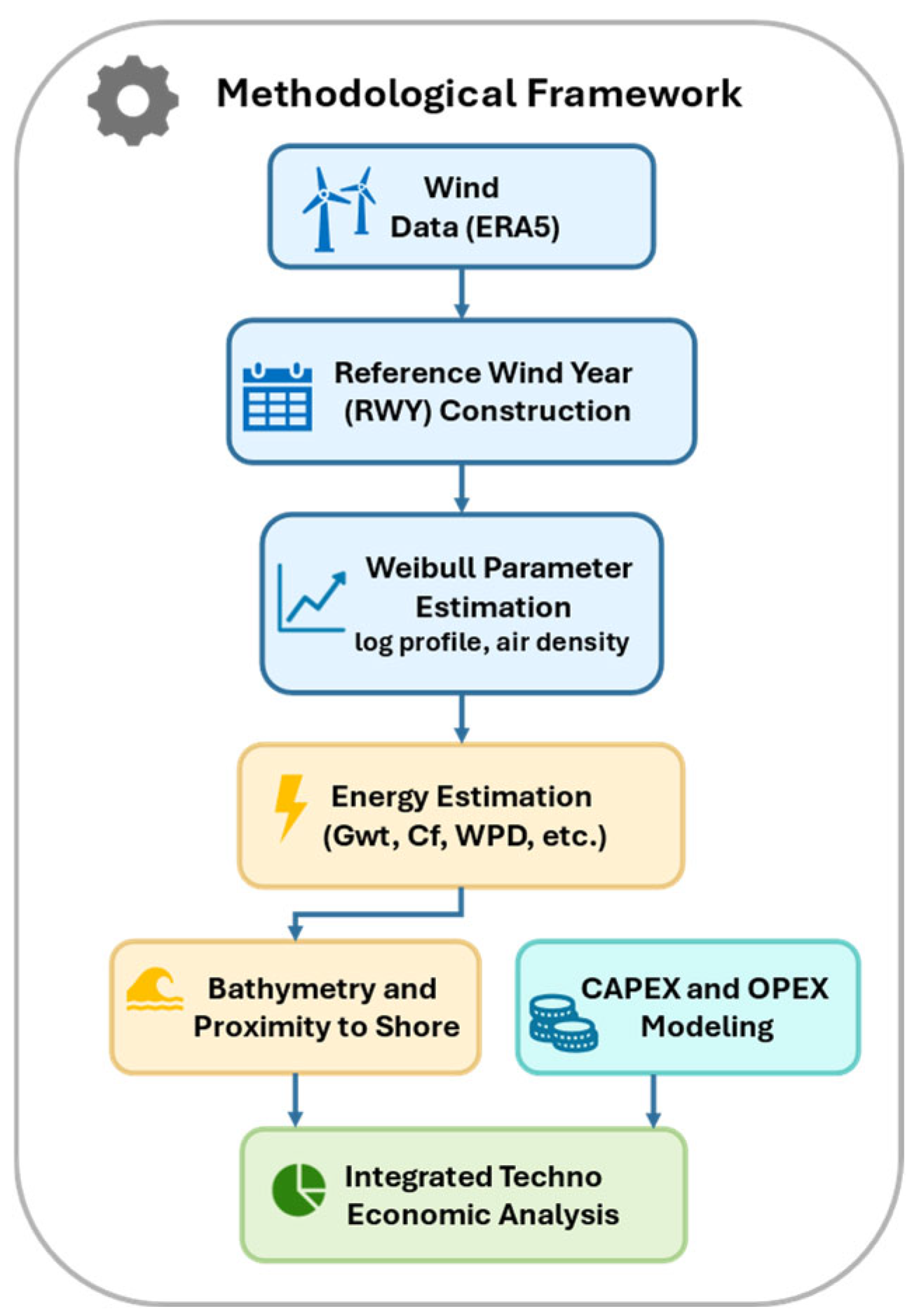
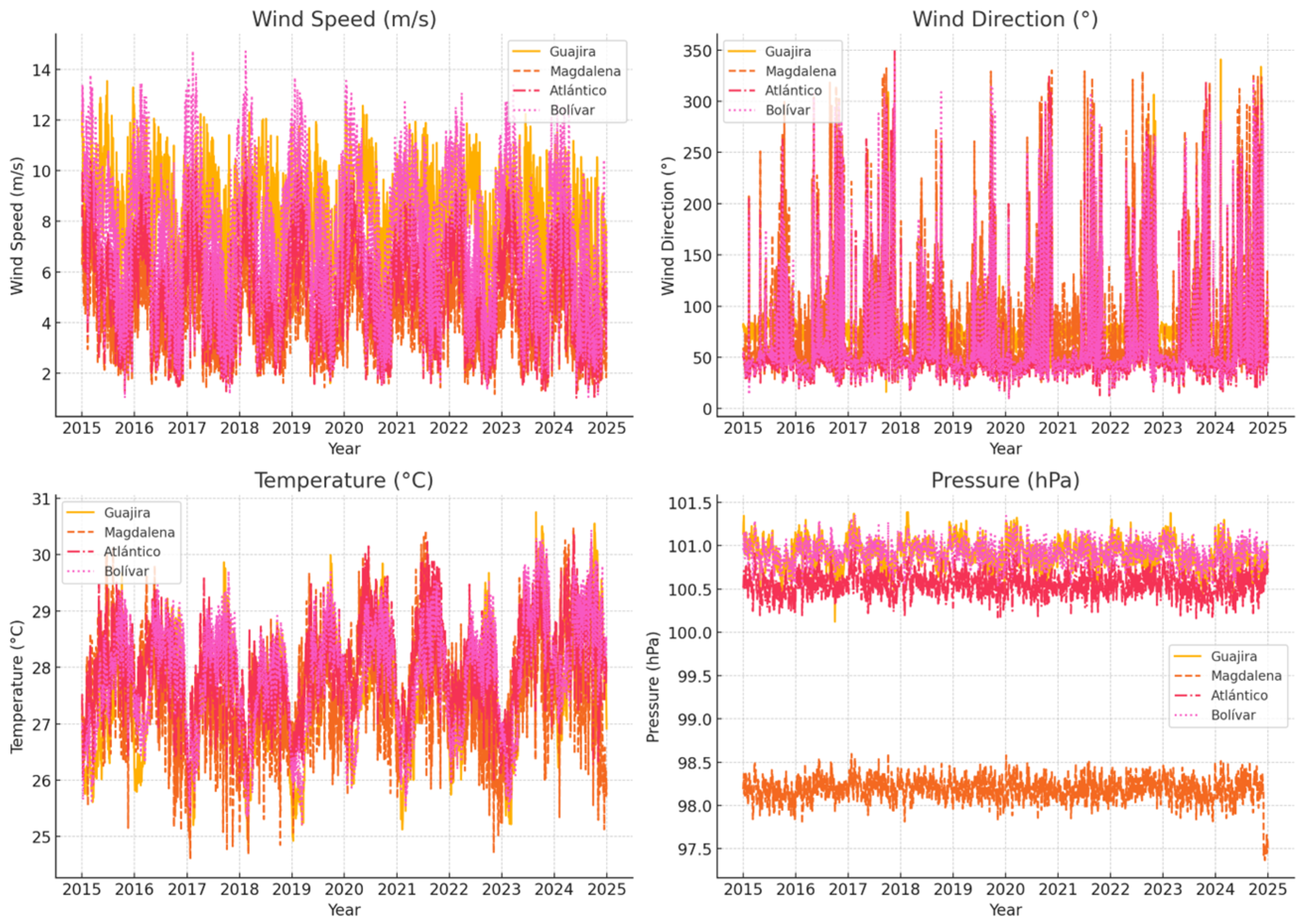

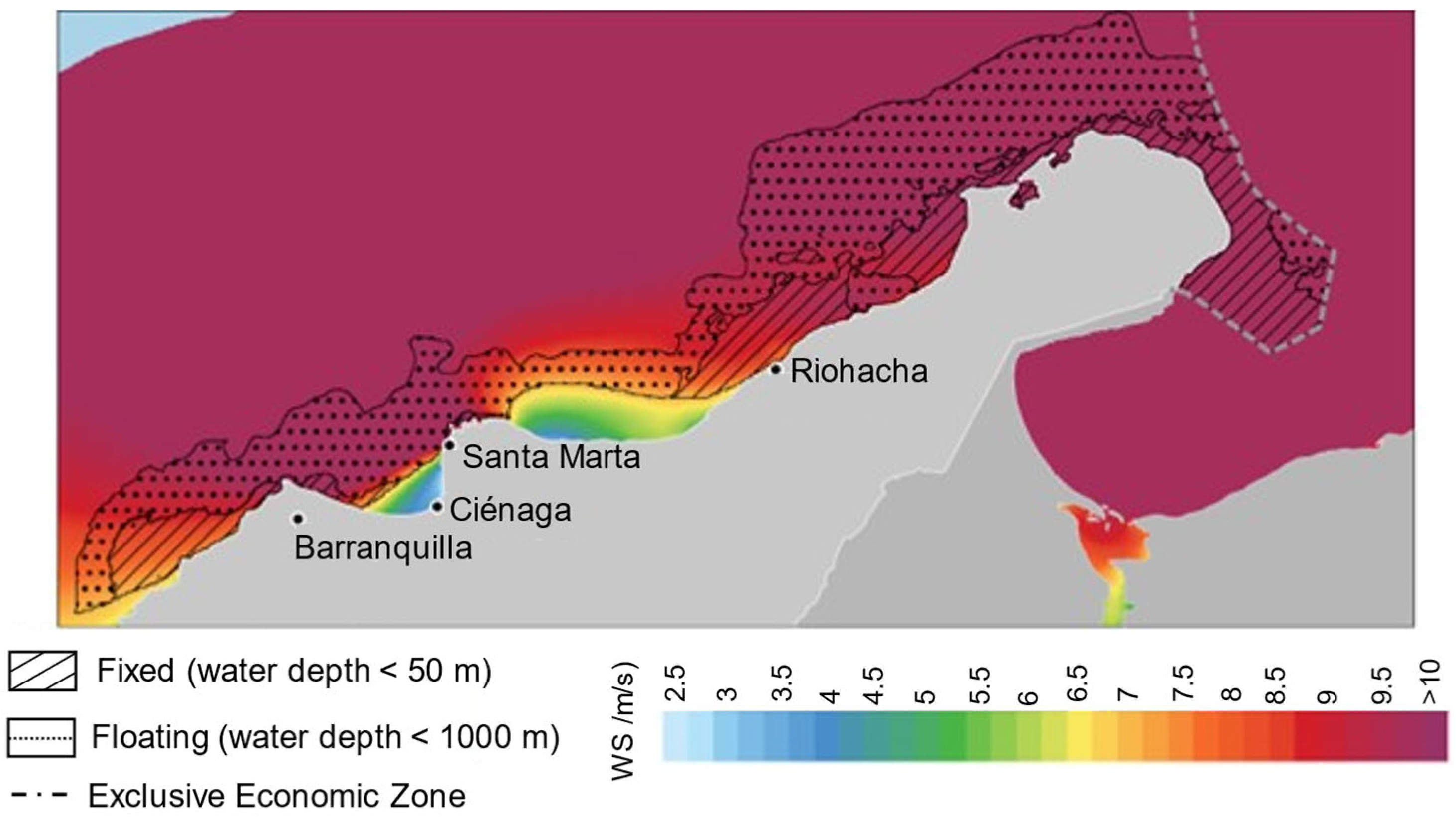


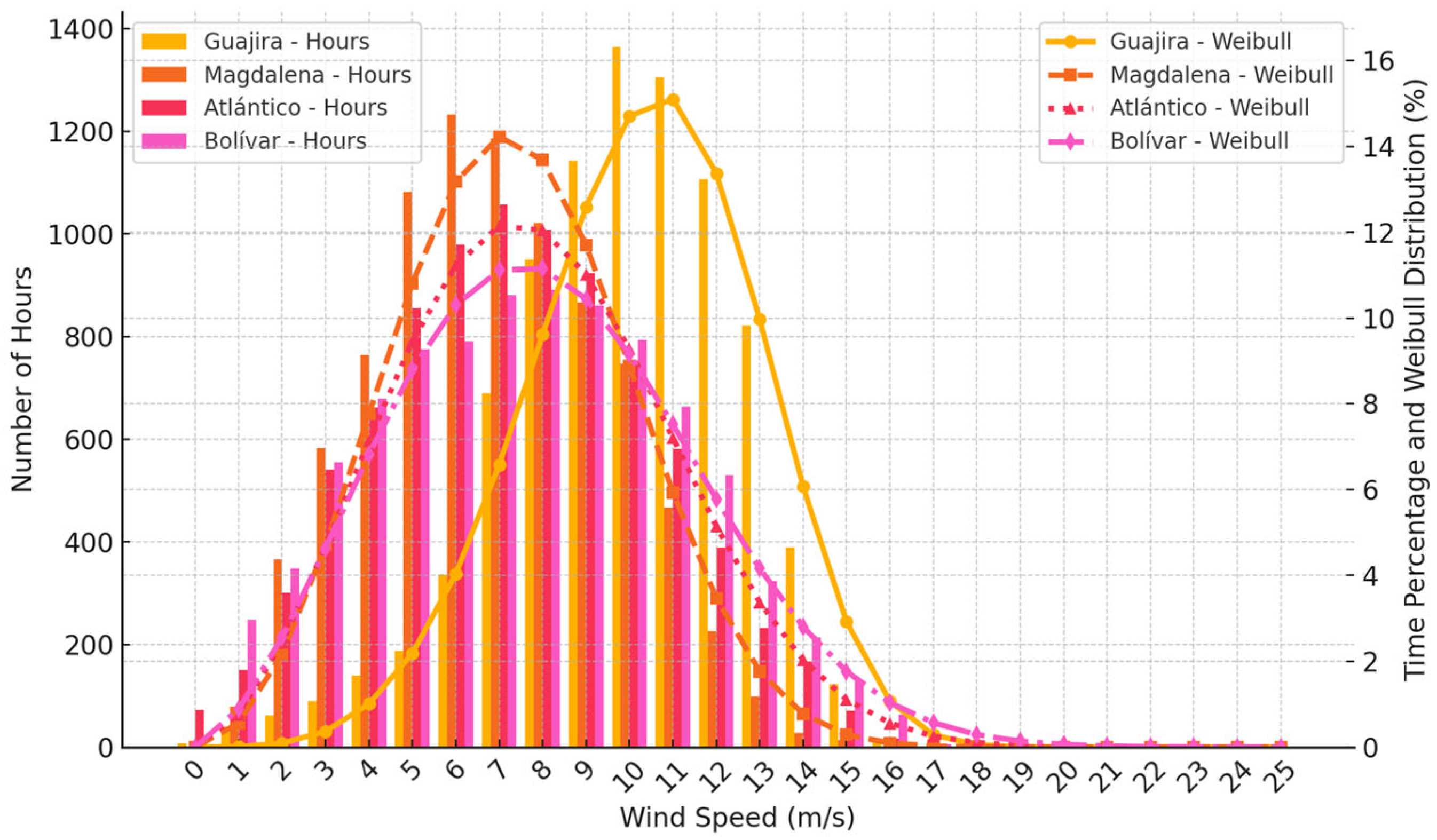
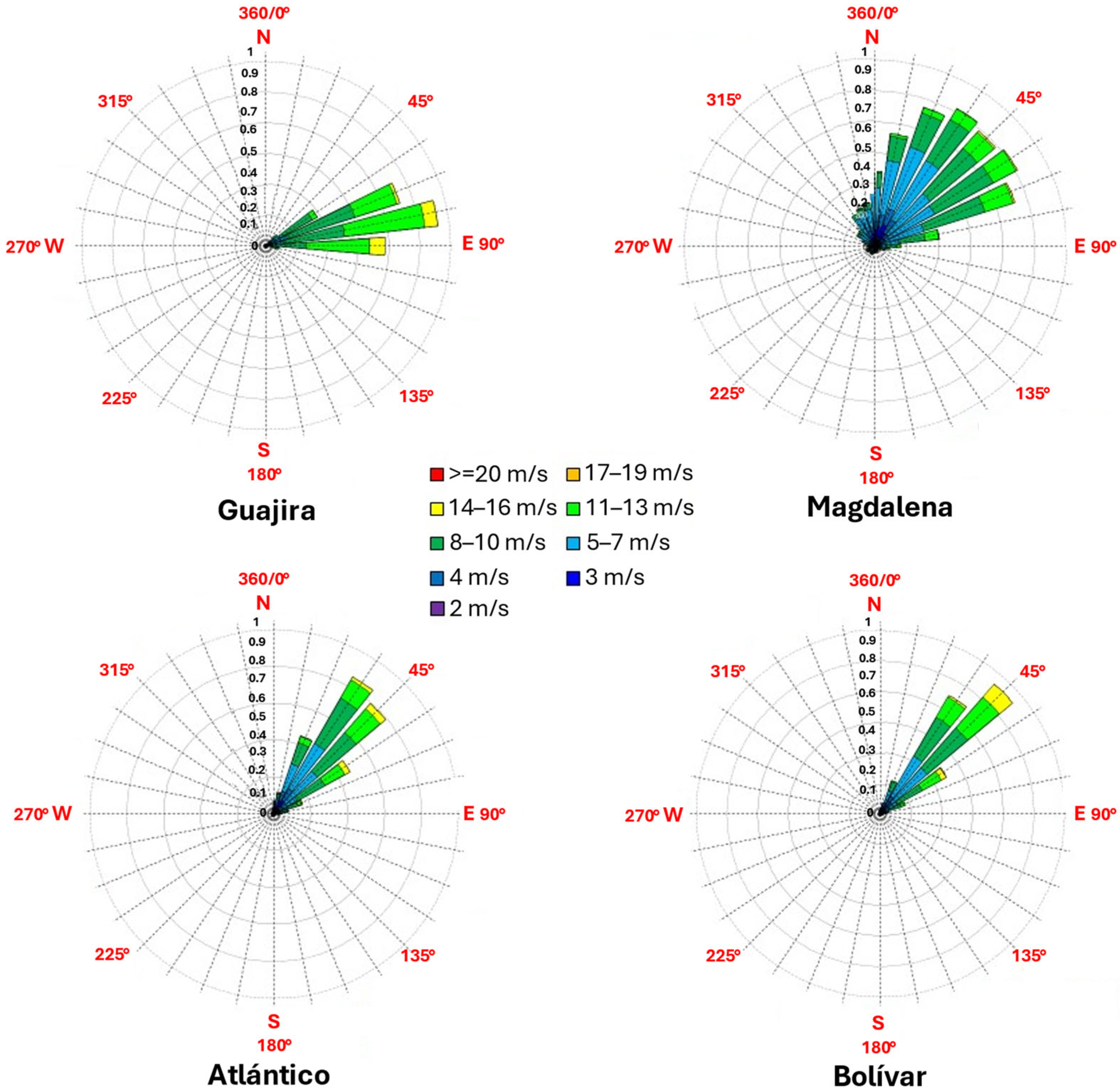
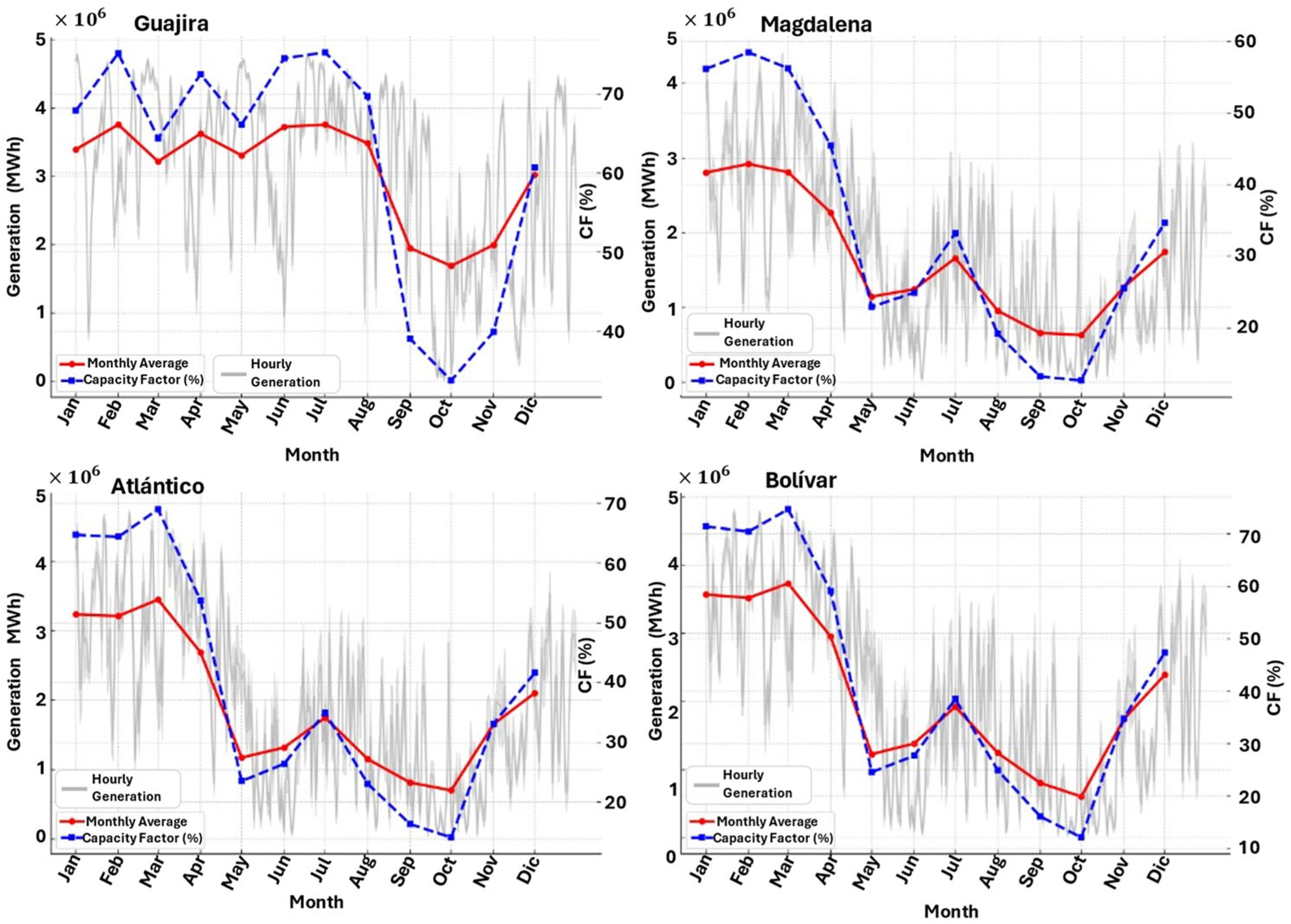
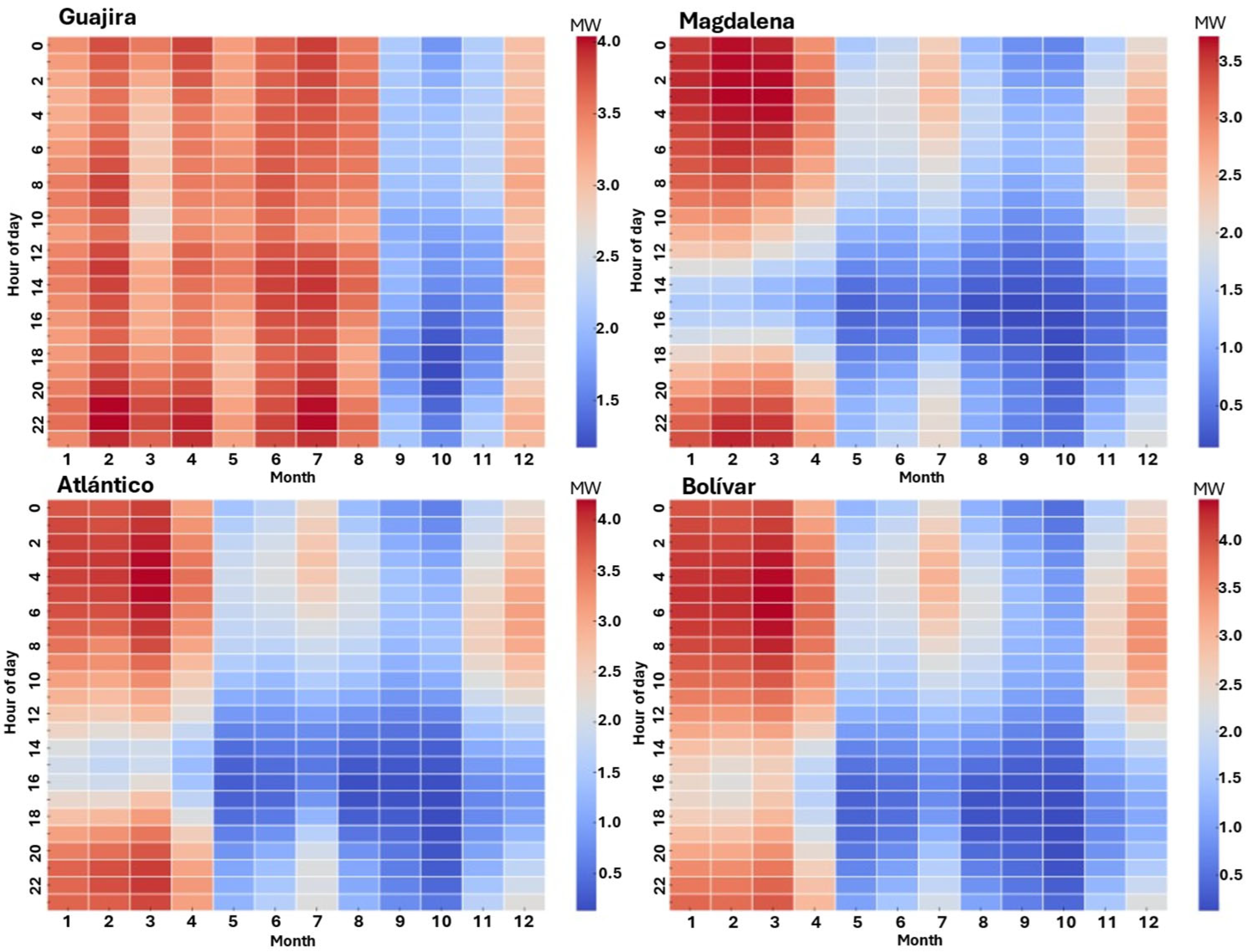


| Department | Jan. | Feb. | Mar. | Apr. | May | Jun. | Jul. | Aug. | Sep. | Oct. | Nov. | Dec. |
|---|---|---|---|---|---|---|---|---|---|---|---|---|
| La Guajira | 2023 | 2019 | 2015 | 2019 | 2017 | 2017 | 2020 | 2022 | 2018 | 2015 | 2016 | 2016 |
| Magdalena | 2022 | 2015 | 2016 | 2016 | 2020 | 2016 | 2023 | 2020 | 2020 | 2017 | 2022 | 2019 |
| Atlántico | 2023 | 2018 | 2018 | 2016 | 2019 | 2016 | 2022 | 2016 | 2020 | 2017 | 2022 | 2017 |
| Bolívar | 2023 | 2015 | 2022 | 2016 | 2024 | 2017 | 2023 | 2017 | 2020 | 2019 | 2022 | 2022 |
| Parameter | Value |
|---|---|
| Rated power, XW (MW) | 5 |
| Cut in wind speed, Ws,min (m/s) | 3 |
| Rated wind speed, Ws,nom (m/s) | 11.4 |
| Cut out wind speed, Ws,max (m/s) | 25 |
| Hub height (m) | 100 |
| Rotor diameter (m) | 126 |
| Rotor swept area, S (m2) | 12,469 |
| Power coefficient, Cp | 0.45 |
| Mechanical losses, Lm | 0.06 |
| Electrical losses, Le | 0.11 |
| Resource Class | WPD (W/m2) | Description |
|---|---|---|
| 1 | 0–200 | Poor |
| 2 | 200–300 | Marginal |
| 3 | 300–400 | Moderate |
| 4 | 400–500 | Good |
| 5 | 500–600 | Excellent |
| 6 | >600 | Outstanding |
| Distance to Shore (km) | Installed Capacity (MW) | Water Depth (m) | CAPEX (MUSD) | Foundation Type | Source |
|---|---|---|---|---|---|
| 19.00 | 100 | 30 | 300.59 | Fixed | [85] |
| 40.00 | 100 | 40 | 350.00 | ||
| 60.00 | 100 | 50 | 400.00 | ||
| 80.00 | 300 | 30 | 903.88 | ||
| 100.00 | 300 | 40 | 950.00 | ||
| 120.00 | 300 | 50 | 1000.00 | ||
| 5.00 | 150 | 15 | 319.48 | Fixed | [86] |
| 11.44 | 75 | 10.99 | 280.73 | Fixed | [87] |
| 13.69 | 75 | 12.91 | 303.42 | ||
| 12.97 | 75 | 15.46 | 327.07 | ||
| 11.42 | 75 | 19.57 | 350.33 | ||
| 5.00 | 5 | 400 | 4.97 | Floating | [88] |
| 3.50 | 40 | 3 | 47.70 | Fixed | [89] |
| 31.00 | 60 | 3 | 79.80 | ||
| 30.00 | 60 | 19 | 383.00 | ||
| 10.00 | 30 | 7 | 82.00 | ||
| 12.50 | 30 | 5 | 105.00 | ||
| 55.00 | 160 | 6 | 278.00 | ||
| 98.00 | 209 | 9 | 407.00 | ||
| 61.00 | 240 | 6 | 269.00 | ||
| 19.00 | 90 | 8 | 181.00 |
| Parameter | La Guajira | Magdalena | Atlántico | Bolívar |
|---|---|---|---|---|
| Latitude (°) | 12.325 | 11.210 | 10.999 | 10.906 |
| Longitude (°) | −72.067 | −74.371 | −75.196 | −75.456 |
| Bathymetry (m) | −32 | −421 | −216 | −41 |
| Foundation type | Fixed | Floating | Floating | Fixed |
| Average wind speed (m/s) | 10.31 | 7.33 | 8.73 | 9.61 |
| Distance to shore (km) | 10 | 23 | 10 | 28.1 |
| Distance to substation (km) | 2 | 4.4 | 13.9 | 9.1 |
| Wind power density (W/m2) | 796 | 340 | 438 | 511 |
| Weibull scale (m/s) | 11.30 | 8.21 | 8.80 | 9.16 |
| Weibull shape | 4.55 | 2.98 | 2.70 | 2.56 |
| Installed capacity (MW) | 400 | 825 | 825 | 570 |
| Capacity factor (%) | 61.5 | 35.2 | 41.8 | 41.7 |
| CAPEX (MUSD) | 1202.36 | 5156.25 | 5156.25 | 1713.36 |
| Annual OPEX (MUSD/year) | 24.05 | 103.13 | 103.13 | 34.27 |
| Component | Cost Share [%] (Fixed/Floating) | La Guajira (Fixed) | Bolívar (Fixed) | Magdalena (Floating) | Atlántico (Floating) |
|---|---|---|---|---|---|
| Turbine (nacelle + rotor + tower) | 33/33 | 396.8 | 565.4 | 1701.6 | 1701.6 |
| Substructure + foundation | 15/30 | 180.4 | 257.0 | 1546.9 | 1546.9 |
| Electrical infrastructure (array + export + grid) | 23/10 | 276.5 | 394.1 | 515.6 | 515.6 |
| Installation and transport | 5/5 | 60.1 | 85.7 | 257.8 | 257.8 |
| Development and lease | 5/4 | 60.1 | 68.5 | 206.3 | 206.3 |
| Soft costs (financing, insurance, contingency, commissioning) | 19/18 | 228.4 | 325.5 | 928.1 | 928.1 |
| Total CAPEX [MUSD] | 100/100 | 1202.4 | 1713.4 | 5156.2 | 5156.2 |
| Risk Category | La Guajira (Fixed) | Bolívar (Fixed) | Atlántico (Floating) | Magdalena (Floating) |
|---|---|---|---|---|
| Metocean extremes | Medium | Medium | Medium–High | High |
| Foundation complexity | Low | Low | High | High |
| Ports and staging capacity | Medium | Medium | High | High |
| Specialized vessel availability | Medium | Medium | High | High |
| Grid-connection readiness | Medium | Medium | Medium | Medium–High |
| Permitting schedule risk | Medium | Medium | High | High |
| O&M access windows | Medium | Medium | High | High |
| Supply chain localization | Medium | Medium | High | High |
Disclaimer/Publisher’s Note: The statements, opinions and data contained in all publications are solely those of the individual author(s) and contributor(s) and not of MDPI and/or the editor(s). MDPI and/or the editor(s) disclaim responsibility for any injury to people or property resulting from any ideas, methods, instructions or products referred to in the content. |
© 2025 by the authors. Licensee MDPI, Basel, Switzerland. This article is an open access article distributed under the terms and conditions of the Creative Commons Attribution (CC BY) license (https://creativecommons.org/licenses/by/4.0/).
Share and Cite
Ospino-Castro, A.; Robles-Algarín, C.; Vásquez Capacho, J.W. Balancing Resource Potential and Investment Costs in Offshore Wind Projects: Evidence from Northern Colombia. Energies 2025, 18, 6003. https://doi.org/10.3390/en18226003
Ospino-Castro A, Robles-Algarín C, Vásquez Capacho JW. Balancing Resource Potential and Investment Costs in Offshore Wind Projects: Evidence from Northern Colombia. Energies. 2025; 18(22):6003. https://doi.org/10.3390/en18226003
Chicago/Turabian StyleOspino-Castro, Adalberto, Carlos Robles-Algarín, and Jhon William Vásquez Capacho. 2025. "Balancing Resource Potential and Investment Costs in Offshore Wind Projects: Evidence from Northern Colombia" Energies 18, no. 22: 6003. https://doi.org/10.3390/en18226003
APA StyleOspino-Castro, A., Robles-Algarín, C., & Vásquez Capacho, J. W. (2025). Balancing Resource Potential and Investment Costs in Offshore Wind Projects: Evidence from Northern Colombia. Energies, 18(22), 6003. https://doi.org/10.3390/en18226003






